What Artist Gained Worldwide Recognition by Showing His Art in the West Bank in 2005?
/https://tf-cmsv2-smithsonianmag-media.s3.amazonaws.com/filer/The-Story-Behind-Banksy-2.jpg)
When Time magazine selected the British artist Banksy—graffiti master, painter, activist, filmmaker and all-purpose provocateur—for its list of the world's 100 most influential people in 2010, he constitute himself in the company of Barack Obama, Steve Jobs and Lady Gaga. He supplied a picture of himself with a newspaper bag (recyclable, naturally) over his head. Almost of his fans don't actually want to know who he is (and accept loudly protested Fleet Street attempts to unmask him). Simply they do want to follow his upward trajectory from the outlaw spraying—or, equally the argot has information technology, "bombing"—walls in Bristol, England, during the 1990s to the artist whose piece of work commands hundreds of thousands of dollars in the auction houses of Britain and America. Today, he has bombed cities from Vienna to San Francisco, Barcelona to Paris and Detroit. And he has moved from graffiti on gritty urban walls to paint on sail, conceptual sculpture and even film, with the guileful documentary Exit Through the Gift Shop, which was nominated for an Academy Honor.
Pest Control, the tongue-in-cheek-titled organization set up past the artist to authenticate the real Banksy artwork, also protects him from prying outsiders. Hiding behind a paper bag, or, more commonly, e-mail, Banksy relentlessly controls his own narrative. His last contiguous interview took place in 2003.
While he may shelter backside a concealed identity, he advocates a straight connexion between an artist and his constituency. "There'south a whole new audience out at that place, and it'southward never been easier to sell [one's fine art]," Banksy has maintained. "You lot don't have to go to college, drag 'circular a portfolio, mail off transparencies to snooty galleries or sleep with someone powerful, all you need now is a few ideas and a broadband connection. This is the first time the substantially bourgeois world of art has belonged to the people. We need to make it count."
***
The Barton Hill commune of Bristol in the 1980s was a scary office of town. Very white—probably no more than three black families had somehow concluded up in that location—working-class, run-downwardly and unwelcoming to strangers. And then when Banksy, who came from a much leafier part of town, decided to go make his first foray there, he was nervous. "My dad was desperately browbeaten upwards in that location as a child," he told fellow graffiti creative person and author Felix Braun. He was trying out names at the time, sometimes signing himself Robin Banx, although this soon evolved into Banksy. The shortened moniker may have demonstrated less of the gangsters' "robbing banks" cachet, but it was more memorable—and easier to write on a wall.
Around this fourth dimension, he also settled on his distinctive stencil approach to graffiti. When he was 18, he once wrote, he was painting a railroad train with a gang of mates when the British Send Police showed upwards and everyone ran. "The residuum of my mates fabricated it to the car," Banksy recalled, "and disappeared so I spent over an hour hidden under a dumper truck with engine oil leaking all over me. Equally I lay there listening to the cops on the tracks, I realized I had to cutting my painting time in half or give information technology up altogether. I was staring direct up at the stenciled plate on the bottom of the fuel tank when I realized I could just copy that style and make each letter three feet high." Only he likewise told his friend, author Tristan Manco: "Equally soon as I cut my starting time stencil I could feel the ability there. I too similar the political border. All graffiti is low-level dissent, merely stencils have an extra history. They've been used to get-go revolutions and to cease wars."
The people—and the apes and rats—he drew in these early on days accept a foreign, primitive experience to them. My favorite is a slice that greets you lot when you enter the Pierced Upward tattoo parlor in Bristol. The wall painting depicts giant wasps (with television receiver sets strapped on equally boosted weapons) divebombing a tempting agglomeration of flowers in a vase. Parlor manager Maryanne Kemp recalls Banksy's marathon painting session: "It was an all-nighter."
By 1999, he was headed to London. He was also starting time to retreat into anonymity. Evading the authorities was one explanation—Banksy "has problems with the cops." Only he likewise discovered that anonymity created its ain invaluable buzz. As his street art appeared in cities across Britain, comparisons to Jean-Michel Basquiat and Keith Haring began circulating.
Banksy'southward offset London exhibition, and so to speak, took place in Rivington Street in 2001, when he and fellow street artists convened in a tunnel near a pub. "We hung up some decorators' signs nicked off a building site," he later wrote, "and painted the walls white wearing overalls. We got the artwork up in 25 minutes and held an opening political party later that week with beers and some hip-hop pumping out of the dorsum of a Transit van. About 500 people turned upwards to an opening which had toll almost goose egg to set upward."
In July 2003, Banksy mounted "Turf War," his breakthrough exhibition. Staged in a onetime warehouse in Hackney, the show dazzled the London fine art scene with its carnival-atmosphere display, which featured a live heifer, its hide embellished with a portrait of Andy Warhol, as well equally Queen Elizabeth II in the guise of a chimpanzee.
Late that year, a tall, bearded figure in a dark overcoat, scarf and floppy chapeau strolled into Tate United kingdom of great britain and northern ireland clutching a large paper bag. He made his mode to Room seven on the second level. He so dug out his own picture, an unsigned oil painting of a rural scene he had found in a London street market place. Across the canvas, which he had titled Crimewatch UK Has Ruined the Countryside for All of Us, he had stenciled blue-and-white police crime-scene record.
During the next 17 months, ever in disguise, Banksy brought his ain make of prankster performance art to major museums, including the Louvre. In that location, he succeeded in installing an epitome of the Mona Lisa plastered with a smiley-face sticker. In New York City, he surreptitiously fastened a small-scale portrait of a adult female (which he had found and modified to depict the subject area wearing a gas mask) to a wall in the Metropolitan Museum of Art. The museum took information technology in step: "I think it's fair to say," spokeswoman Elyse Topalian told theNew York Times, "information technology would take more than a slice of Scotch tape to get a work of art into the Met."
Banksy became an international star in 2005. In August, he arrived in Israel, where he painted a series of images on the West Bank's concrete wall, part of the bulwark congenital to try to end suicide bombers. Images of a girl clutching balloons as she is transported to the pinnacle of a wall; ii stenciled children with bucket and spade dreaming of a embankment; and a boy with a ladder propped confronting the wall were poignant meditations on the theme of escape.
Two months after returning from Israel, Banksy's London exhibition "Crude Oils" took the art of the subversive brew-upwards to new heights—Claude Monet'sWater Lilies reworked to include trash and shopping carts floating amongst lily pads; a street hooligan smashing the window depicted in a reimagining of Edward Hopper'due south Dark Hawks. A signature Banksy touch included 164 rats—live rats—skittering around the gallery and testing critics' mettle.
At that place was an inevitability to Banksy's incursion into Los Angeles with the show "Barely Legal" in September 2006. "Hollywood," he in one case said, "is a boondocks where they honor their heroes past writing their names on the pavement to be walked on by fat people and peed on by dogs. It seemed like a great identify to come and be aggressive." Crowds of thirty,000 or then, among them Brad Pitt, were in attendance. "[Banksy] does all this and he stays bearding," Pitt told theLA Times, almost wistfully. "I recollect that's keen."
The exhibition centerpiece was an 8,000-pound alive elephant, slathered in ruby paint and overlaid with a fleur-de-lis pattern. 50.A.'s outspoken creature-rights advocates were incensed; the authorities ordered the paint to be washed off. Fliers distributed to the glittering oversupply fabricated the bespeak that "In that location's an elephant in the room...20 billion people live below the poverty line."
In February 2008, seven months earlier the collapse of Lehman Brothers, New York's rich and famous gathered at Sotheby'due south for a night of serious spending. The effect, organized by Bono, artist Damien Hirst, Sotheby'due south and the Gagosian Gallery, turned out to be the biggest charity art auction ever, raising $42.5 million to support AIDS programs in Africa.
Banksy'sRuined Mural, a pastoral scene with the slogan "This is not a photograph opportunity" pasted across information technology, sold for $385,000.A Vandalized Telephone Box, an bodily British phone booth bent nearly 90 degrees and bleeding cherry paint where a selectionax had pierced information technology, commanded $605,000. Three years later the buyer was revealed to be Mark Getty, grandson of J. Paul Getty.
Banksy took on the medium of pic inExit Through the Gift Shop, an antic, sideways 2010 documentary on the creation and marketing of street fine art. TheNew York Times described it as paralleling Banksy'due south all-time piece of work: "a trompe l'oeil: a film that looks like a documentary but feels like a awe-inspiring con." It was brusque-listed for an Oscar in the 2010 documentary category.
When the Museum of Contemporary Fine art, Los Angeles put on its comprehensive survey of street art and graffiti in 2011, Banksy was well represented in the field of 50 artists. The show was a high-profile demonstration of the phenomenon that has come to exist known as the "Banksy effect"—the artist'southward phenomenal success in bringing urban, outsider art into the cultural, and increasingly profitable, mainstream.
It could be said that Banksy's subversiveness diminishes as his prices rise. He may well have reached the tipping indicate where his success makes information technology incommunicable for him to remain rooted in the subculture he emerged from.
The riots in the Stokes Croft area of Bristol in jump 2011 offer a cautionary tale. The episode began after police raided protesters, who were opposed to the opening of a Tesco Metro supermarket and living as squatters in a nearby apartment. The regime later said that they took action after receiving information that the grouping was making petrol bombs. Banksy's response was to produce a £five "commemorative gift poster" of a "Tesco Value Petrol Bomb," its fuse alight. The proceeds, he stated on his website, were to get to the People's Republic of Stokes Croft, a neighborhood-revival organization. Banksy'southward generosity was non universally welcomed. Critics denounced the creative person as a "Champagne Socialist."
He has countered this kind of charge repeatedly, for instance, telling theNew Yorker by e-mail: "I requite away thousands of paintings for gratis. I don't think it's possible to make fine art most world poverty and trouser all the cash." (On his website, he provides loftier-resolution images of his work for free downloading.)
The irony, he added, that his anti-establishment fine art commands huge prices isn't lost on him. "I dear the way capitalism finds a place—fifty-fifty for its enemies. Information technology's definitely boom fourth dimension in the discontent industry. I mean how many cakes does Michael Moore get through?"
While the value of his pieces soars, a poignancy attends some of Banksy's artistic output. A number of his works exist just in memory, or photographs. When I recently wandered in London, searching for 52 previously documented examples of Banksy's street art, 40 works had disappeared altogether, whitewashed over or destroyed.
Fittingly, the latest chapter in the enigmatic Banksy's saga involves an unsolved mystery. This summertime, during the London Games, he posted 2 images of Olympic-themed pieces online—a javelin thrower lobbing a missile, and a pole vaulter soaring over a barbed-wire fence. Naturally, a Banksyan twist occurs: The locations of this street fine art remain undisclosed. Somewhere in London, a pair of new Banksys wait discovery.
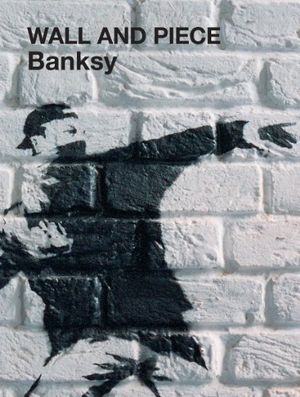
Wall and Slice
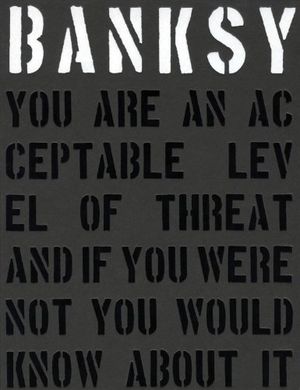
Banksy.: You Are an Acceptable Level of Threat
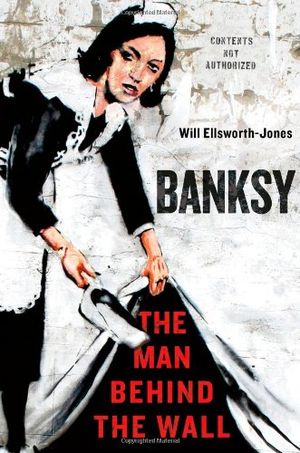
Banksy: The Human being Behind the Wall
Source: https://www.smithsonianmag.com/arts-culture/the-story-behind-banksy-4310304/
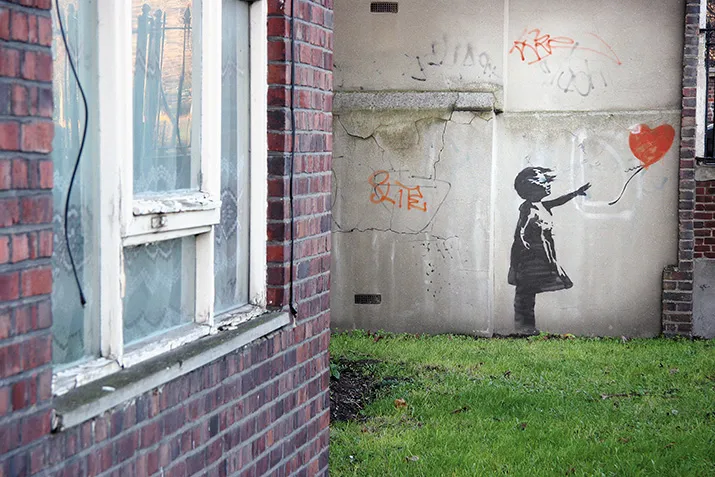
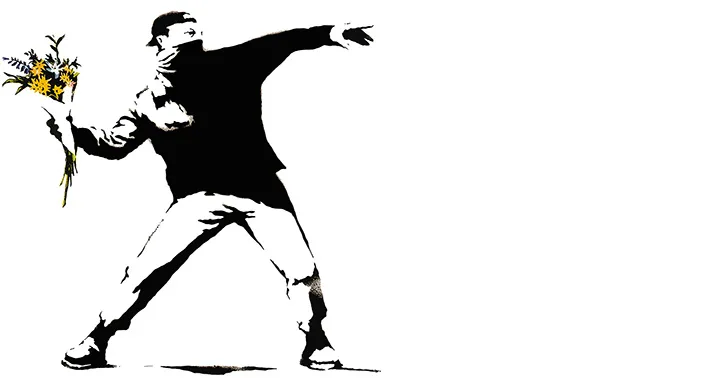
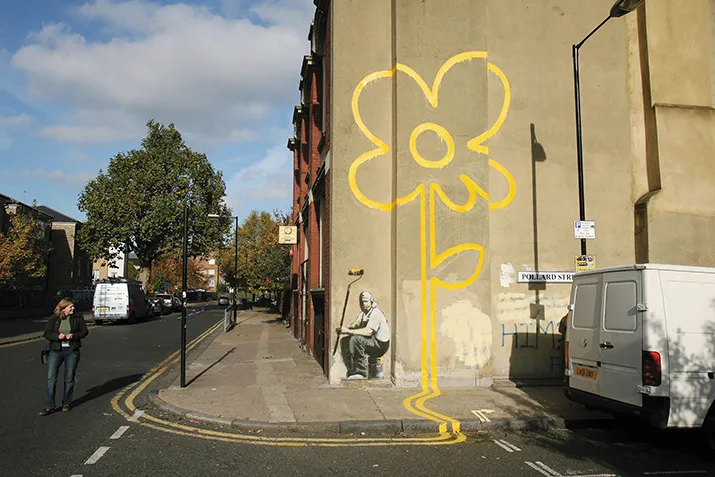
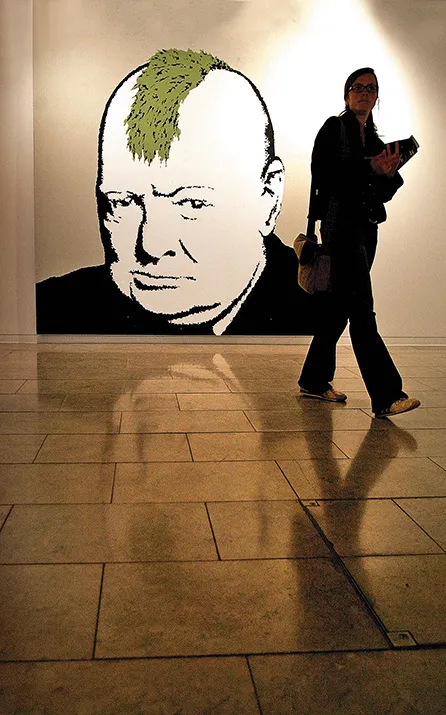
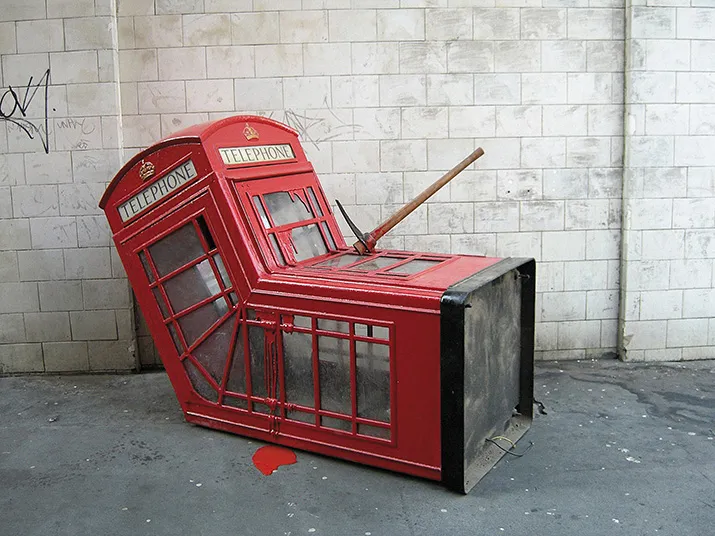
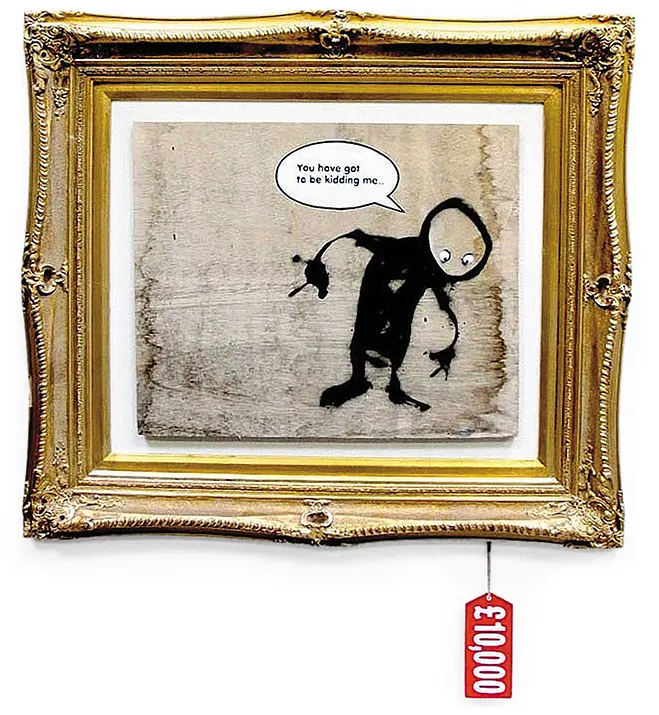
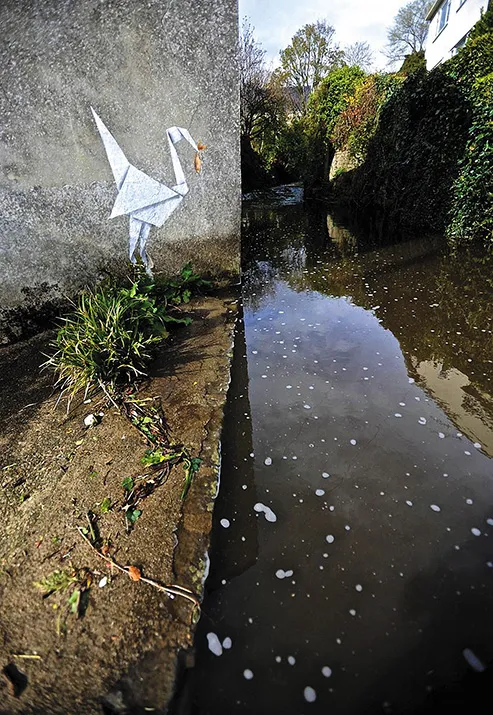
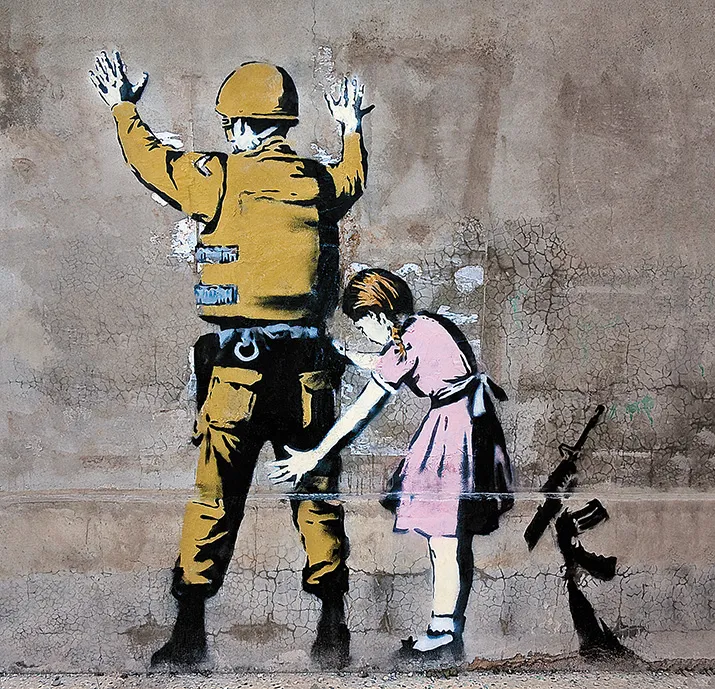
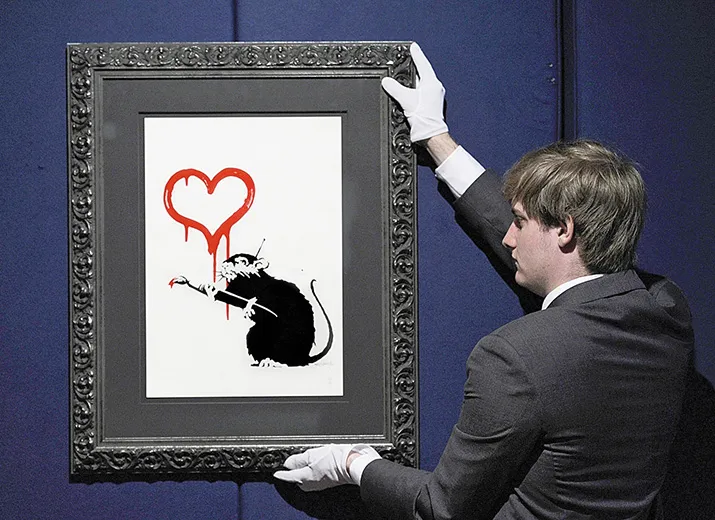
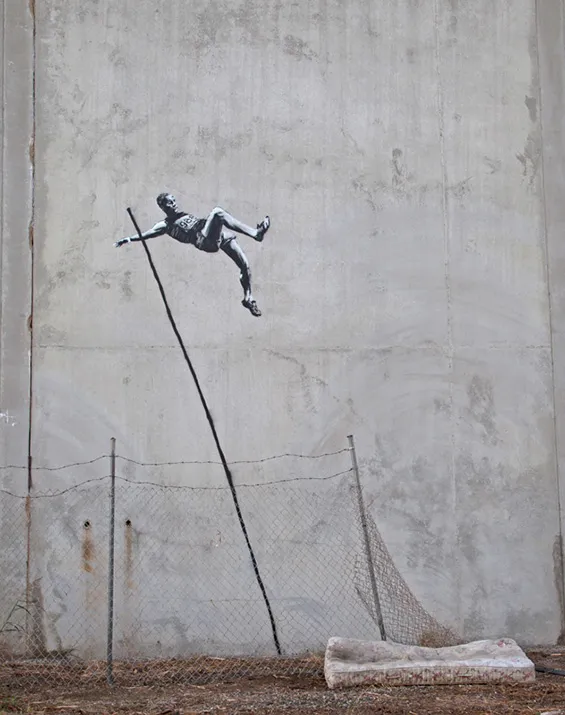
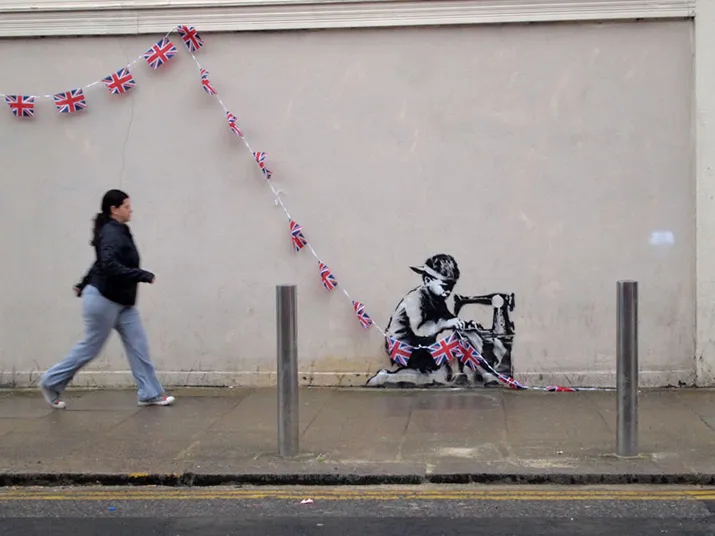
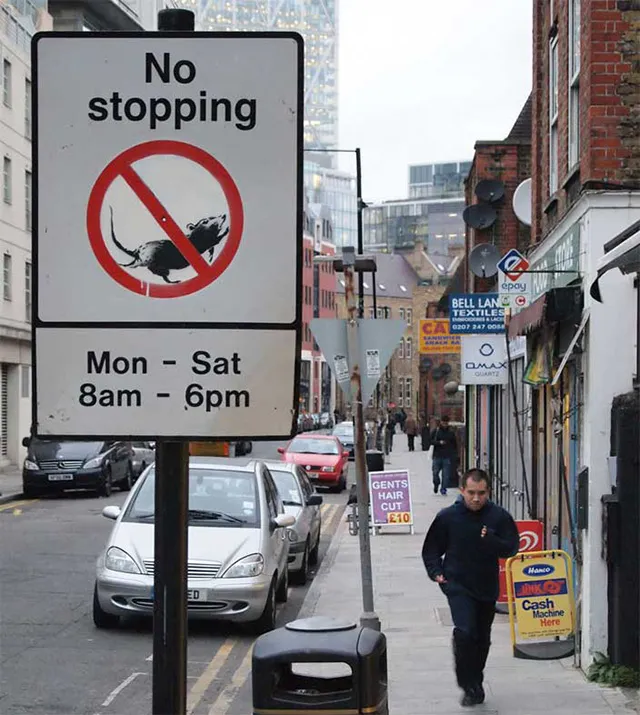
0 Response to "What Artist Gained Worldwide Recognition by Showing His Art in the West Bank in 2005?"
Post a Comment